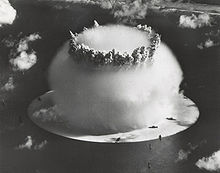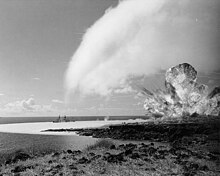Condensation cloud: Difference between revisions
→Non-nuclear explosions: remove subjective statement |
TornadoLGS (talk | contribs) →Non-nuclear explosions: Added info + refs, a few wording changes, |
||
| Line 24: | Line 24: | ||
===Non-nuclear explosions=== |
===Non-nuclear explosions=== |
||
[[File:TNT detonation on Kahoolawe Island during Operation Sailoir Hat, sjot Bravo, 1965.jpg|thumb|500 tons of [[trinitrotoluene|TNT]] detonated during [[Operation Sailor Hat]], showing a Wilson cloud]] |
[[File:TNT detonation on Kahoolawe Island during Operation Sailoir Hat, sjot Bravo, 1965.jpg|thumb|500 tons of [[trinitrotoluene|TNT]] detonated during [[Operation Sailor Hat]], showing a Wilson cloud]] |
||
Any sufficiently large explosion, such as |
Any sufficiently large explosion, such as one caused by a large quantity of conventional explosives or a volcanic eruption, can create condensation cloud,<ref name="c&en Beirut">{{cite web |last1=Howes |first1=Laura |title=The chemistry behind the Beirut explosion |url=https://cen.acs.org/safety/industrial-safety/chemistry-behind-Beirut-explosion/98/web/2020/08 |website=Chemical and Egineering News |accessdate=7 August 2020 |date=5 August 2020}}</ref><ref>{{cite journal |last1=Yokoo |first1=Akihiko |last2=Ishihara |first2=Kazuhiro |title=Analysis of pressure waves observed in Sakurajima eruption movies |journal=Earth, Planets, and Space |date=23 March 2007 |volume=59 |issue=3 |pages=177-181 |doi=10.1186/BF03352691 |url=https://earth-planets-space.springeropen.com/articles/10.1186/BF03352691 |accessdate=7 August 2020}}</ref> as seen in [[Operation Sailor Hat]]<ref>{{cite web |title=KN-11352 Operation "Sailor Hat", 1965 |url=https://www.history.navy.mil/our-collections/photography/numerical-list-of-images/nara-series/kn-series/KN-10000/KN-11352.html |publisher=Naval History and Heritage Command |accessdate=7 August 2020}}</ref> or in the 2020 [[2020 Beirut explosions|Beirut Port explosion]], where a very large Wilson cloud expanded outwards from the blast.<ref name="c&en Beirut"/> |
||
<!--- Heads up, Aug 2020: The image "File:Beirut explosion condensation cloud.jpg" has been added here a couple of times and removed. Be aware that it is a copyrighted image, and will likely be removed from system per [[WP:NFCCE]] when wait period is over ---> |
<!--- Heads up, Aug 2020: The image "File:Beirut explosion condensation cloud.jpg" has been added here a couple of times and removed. Be aware that it is a copyrighted image, and will likely be removed from system per [[WP:NFCCE]] when wait period is over ---> |
||
Revision as of 20:59, 7 August 2020
This article relies largely or entirely on a single source. (May 2010) |


A transient condensation cloud, also called Wilson cloud, is observable at large explosions in humid air.
When a nuclear weapon or a large amount of a conventional explosive is detonated in sufficiently humid air, the "negative phase" of the shock wave causes a rarefaction of the air surrounding the explosion, but not contained within it. This rarefaction results in a temporary cooling of that air, which causes a condensation of some of the water vapor contained in it. When the pressure and the temperature return to normal, the Wilson cloud dissipates.[1]
Mechanism
Since heat does not leave the affected air mass, this change of pressure is adiabatic, with an associated change of temperature. In humid air, the drop in temperature in the most rarefied portion of the shock wave can bring the air temperature below its dew point, at which moisture condenses to form a visible cloud of microscopic water droplets. Since the pressure effect of the wave is reduced by its expansion (the same pressure effect is spread over a larger radius), the vapor effect also has a limited radius. Such vapor can also be seen in low pressure regions during high–g subsonic maneuvers of aircraft in humid conditions.
Occurrence
Nuclear weapons testing
Scientists observing the Operation Crossroads nuclear tests in 1946 at Bikini Atoll named that transitory cloud a "Wilson cloud" because of its similarity to the appearance of the inside of a Wilson cloud chamber. The cloud chamber effect is caused by a temporary reduction in pressure in a closed system and marks the tracks of electrically-charged sub-atomic particles. Analysts of later nuclear bomb tests used the more general term condensation cloud.
The shape of the shock wave, influenced by different speed in different altitudes, and the temperature and humidity of different atmospheric layers determines the appearance of the Wilson clouds. During nuclear tests, condensation rings around or above the fireball are commonly observed. Rings around the fireball may become stable and form rings around the rising stem of the mushroom cloud.
The lifetime of the Wilson cloud during nuclear air bursts can be shortened by the thermal radiation from the fireball, which heats the cloud above to the dew point and evaporates the droplets.
Non-nuclear explosions

Any sufficiently large explosion, such as one caused by a large quantity of conventional explosives or a volcanic eruption, can create condensation cloud,[2][3] as seen in Operation Sailor Hat[4] or in the 2020 Beirut Port explosion, where a very large Wilson cloud expanded outwards from the blast.[2]
Aircraft
The same kind of condensation cloud is sometimes seen above the wings of aircraft in a moist atmosphere. The top of a wing has a reduction of air pressure as part of the process of generating lift. This reduction in air pressure causes a cooling, just as above, and the condensation of water vapor. Hence, the small, transient clouds that appear.
The vapor cone of a transonic aircraft is another example of a condensation cloud.
References
- ^ Glasstone, Samuel and Philip J. Dolan. The Effects of Nuclear Weapons, U.S. Dept. Of Defense/ Dept. Of Energy; 3rd Edition (1977), p. 631
- ^ a b Howes, Laura (5 August 2020). "The chemistry behind the Beirut explosion". Chemical and Egineering News. Retrieved 7 August 2020.
- ^ Yokoo, Akihiko; Ishihara, Kazuhiro (23 March 2007). "Analysis of pressure waves observed in Sakurajima eruption movies". Earth, Planets, and Space. 59 (3): 177–181. doi:10.1186/BF03352691. Retrieved 7 August 2020.
{{cite journal}}: CS1 maint: unflagged free DOI (link) - ^ "KN-11352 Operation "Sailor Hat", 1965". Naval History and Heritage Command. Retrieved 7 August 2020.
